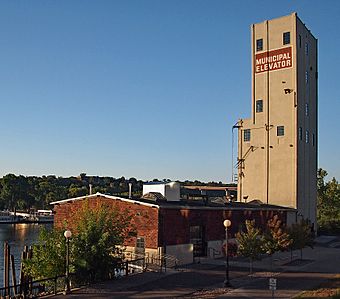Saint Paul Municipal Grain Terminal facts for kids
Quick facts for kids |
|
|
Saint Paul Municipal Grain Terminal
|
|

The Saint Paul Municipal Grain Terminal from the northeast
|
|
| Location | 266 Old Shepard Road Saint Paul, Minnesota |
|---|---|
| Built | 1927–1931 |
| MPS | Grain Elevator Design in Minnesota MPS |
| NRHP reference No. | 04000721 |
| Added to NRHP | July 21, 2004 |
The Saint Paul Municipal Grain Terminal is a very old building in Saint Paul, Minnesota. It sits right over the Mississippi River. People also call it the "head house" or "sack house." It was built a long time ago, between 1927 and 1931. This building shows how important Saint Paul used to be as a port city on the Mississippi River. In 2004, it was added to the National Register of Historic Places, which means it's a special historical site.
History of the Grain Terminal
This building is important because it was the first successful grain elevator owned and run by a group of farmers in the United States. A grain elevator is a tall building used to store grain. This place once had 90 large silos for grain. It also had a small mill and special areas to load grain onto boats and trains. There was even a "sack house" where they put milled flour into bags.
Where to Find the City House
The Grain Terminal is located at 266 Old Shepard Road in Saint Paul, Minnesota. Today, it has been fixed up and is called "City House." You can rent it for meetings, parties, and other events.
Not long ago, this building was almost torn down. It was even listed as one of Minnesota's most endangered historic places. But now, it's a special park building, a place to learn about history, and an event space. It's called City House, just like it was during the 1920s and 1930s when farmers worked together.
In 2001, there were plans to rebuild the area around the terminal. This area used to be an industrial site. But the old grain terminal was in bad shape, which caused problems for the plans. To solve this, a group was formed. It included people from the city, historians, and others. They agreed that the buildings were important and should be saved if possible.
To get ideas for fixing up the grain terminal, a contest was held in 2002. It was called the WHAZIT! Contest. Over 200 ideas came in from all over the U.S. and 13 other countries. The city council looked at these ideas to find the best ones.
After plans for a restaurant didn't work out, the city and other groups worked to turn the site into a park building. It became a place for trails, a learning center, and an event space. They got a big grant of $1 million to help fix the building. Other money came from the state of Minnesota and other local groups. Money was also raised to create exhibits about the building's history. The total cost to fix up the building and create the exhibits was over $3 million. An award-winning company called Meyer Sherer Rockcastle was the architect for the City House project.
Because of its important role in the farmers' cooperative movement and river shipping, the building was added to the National Register of Historic Places in 2004.
Today, Saint Paul Parks and Recreation manages City House. It is open from morning until evening. The building hangs out over the Mississippi River, giving amazing views of the river valley and the city skyline.



